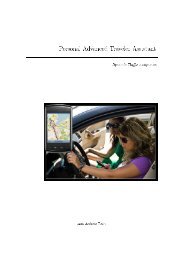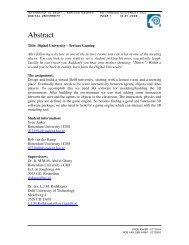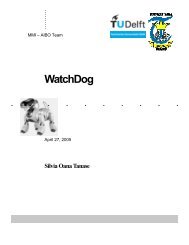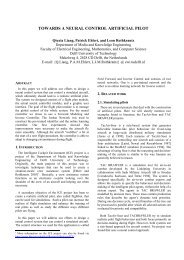Recognition of facial expressions - Knowledge Based Systems ...
Recognition of facial expressions - Knowledge Based Systems ...
Recognition of facial expressions - Knowledge Based Systems ...
You also want an ePaper? Increase the reach of your titles
YUMPU automatically turns print PDFs into web optimized ePapers that Google loves.
The Kalman filter method used for tracking the<br />
eyes presents a high efficiency by reducing the<br />
error <strong>of</strong> the coordinate estimation task. In<br />
addition to that, the process does not require a<br />
high processor load and a real time<br />
implementation was possible.<br />
4 Face representational model<br />
The <strong>facial</strong> expression recognition system handles<br />
the input video stream and performs analysis on<br />
the existent frontal face. In addition to the set <strong>of</strong><br />
degree values related to the detected <strong>expressions</strong>,<br />
the system can also output a graphical face<br />
model.<br />
The result may be seen as a feedback <strong>of</strong> the<br />
system to the given <strong>facial</strong> expression <strong>of</strong> the<br />
person whose face is analyzed and it may be<br />
different <strong>of</strong> that. One direct application <strong>of</strong> the<br />
chosen architecture may be in design <strong>of</strong> systems<br />
that perceive and interact with humans by using<br />
natural communication channels.<br />
In our approach the result is directly associated<br />
to the expression <strong>of</strong> the input face (see Figure 2).<br />
Given the parameters from the expression<br />
recognition module, the system computes the<br />
shape <strong>of</strong> different visual features and generates a<br />
2D graphical face model.<br />
Figure 2. Response <strong>of</strong> the expression recognition<br />
The geometrical shape <strong>of</strong> each visual feature<br />
follows certain rules that aim to set the outlook<br />
to convey the appropriate emotional meaning.<br />
Each feature is reconstructed using circles and<br />
simple polynomial functions as lines, parabola<br />
parts and cubic functions. A five-pixel window is<br />
used to smooth peaks so as to provide shapes<br />
with a more realistic appearance.<br />
The eye upper and lower lid was approximated<br />
with the same cubic function. The eyebrow’s<br />
thickness above and below the middle line was<br />
calculated from three segments as a parabola, a<br />
straight line and a quarter <strong>of</strong> a circle as the inner<br />
corner. A thickness function was added and<br />
subtracted to and from the middle line <strong>of</strong> the<br />
eyebrow. The shape <strong>of</strong> the mouth varies strongly<br />
as emotion changes from sadness to happiness or<br />
disgust.<br />
The manipulation <strong>of</strong> the face for setting a certain<br />
expression implies to mix different emotions.<br />
Each emotion has a percentage value by which<br />
they contribute to the face general expression.<br />
The new control set values for the visual features<br />
are computed by the difference <strong>of</strong> each emotion<br />
control set and the neutral face control set, and<br />
make a linear combination <strong>of</strong> the resulting six<br />
vectors.<br />
5 Visual feature acquisition<br />
The objective <strong>of</strong> the first processing component<br />
<strong>of</strong> the system is to recover the position <strong>of</strong> some<br />
key points on the face surface. The process starts<br />
with the stage <strong>of</strong> eye coordinate detection.<br />
Certified FACS coders coded the image data.<br />
Starting from the image database, we processed<br />
each image and obtained the set <strong>of</strong> 30 points<br />
according to Kobayashi & Hara model [9]. The<br />
analysis was semi-automatic.<br />
A new transformation was involved then to get<br />
the key points as described in figure 3. The<br />
coordinates <strong>of</strong> the last set <strong>of</strong> points were used for<br />
computing the values <strong>of</strong> the parameters<br />
presented in table 2. The preprocessing tasks<br />
implied some additional requirements to be<br />
satisfied. First, for each image a new coordinate<br />
system was set. The origin <strong>of</strong> the new coordinate<br />
system was set to the nose top <strong>of</strong> the individual.<br />
The value <strong>of</strong> a new parameter called base was<br />
computed to measure the distance between the<br />
eyes <strong>of</strong> the person in the image. The next<br />
processing was the rotation <strong>of</strong> all the points in<br />
the image with respect to the center <strong>of</strong> the new<br />
coordinate system. The result was the frontal<br />
face with correction to the <strong>facial</strong> inclination. The<br />
final step <strong>of</strong> preprocessing was related to scale<br />
all the distances so as to be invariant to the size<br />
<strong>of</strong> the image.<br />
Eventually a set <strong>of</strong> 15 values for each <strong>of</strong> the<br />
image was obtained as the result <strong>of</strong><br />
preprocessing stage. The parameters were<br />
computed by taking both the variance observed<br />
in the frame at the time <strong>of</strong> analysis and the<br />
temporal variance. Each <strong>of</strong> the last three<br />
parameters was quantified so as to express a<br />
linear behavior with respect to the range <strong>of</strong> <strong>facial</strong><br />
<strong>expressions</strong> analyzed.<br />
The technique used was Principal Component<br />
Analysis oriented pattern recognition for each <strong>of</strong><br />
the three <strong>facial</strong> areas. The technique was first<br />
applied by Turk and Pentland for face imaging<br />
[11]. The PCA processing is run separately for<br />
each area and three sets <strong>of</strong> eigenvectors are<br />
128
















